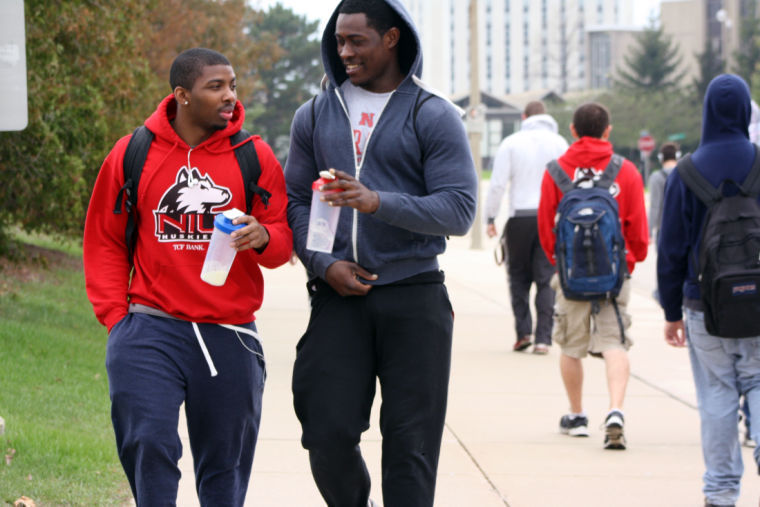Projected enrollment drop hurts financially
Freshman psychology major Jason Betts Jr. (left) and sophomore English major Jalen Olajuwon walk down Lucinda Avenue on April 28, 2014, following a workout at the Recreation Center.
April 28, 2014
NIU expects a drop in total enrollment of up to 800 students for the 2014-2015 academic year, during which potential state budget cuts could place a higher burden on tuition, fees and room and board for revenue.
Tuition, fees and room and board made up 55 percent of the university’s revenue for fiscal year 2014, said Nancy Suttenfield, interim chief financial officer, during a Bold Futures Workshop presentation.
A new baseline revenue budget attributes a decrease of $16.2 million in revenue in those three areas to the predicted enrollment drop and a potential 12.5 percent state funding cut.
The baseline revenue budget attributes a decrease of $11.7 million in state appropriations to the projected 12.5 percent state budget cut affecting Illinois public higher education institutions. These reductions place emphasis on enrollment to make up for future revenue loss, according to Suttenfield’s presentation.
Overall enrollment has declined by 15 percent and occupied beds have dropped by 30 percent since fiscal year 2002, according to Suttenfield’s presentation.
“We can’t control state appropriations and it’s unlikely that they will turn around in the near term,” Suttenfield said in her presentation on Bold Futures. “So, unless we work together to turn on the revenue driver that NIU does control, which is our enrollment, our baseline revenue is unlikely to recover.”
The number of newly enrolled transfer students — 1,881 in fall 2013 — has decreased by 413 since fall 2010, while the number of enrolled freshmen students — 2,679 in fall 2013 — has decreased by 26 since fall 2010, but has been rising since hitting 2,590 in fall 2011.
Eric Weldy, vice president for Student Affairs and Enrollment Management, said prospective students aren’t coming to NIU in sustainable numbers because there are fewer of them and there are more opportunities to attend other schools.
“The pool of students at the high school level as well as those who transfer from community colleges are low state-wide, which is nothing universities are surprised about, but it makes things more competitive,” Weldy said. “Back in my day, in the ’80s, kids applied to two or more schools. Students today apply for many schools.”
Weldy said the university has been focusing on communication with community colleges and high schools in an effort to increase enrollment, and the record turnout at this year’s Spring Open House was an indication of that effort.
Paul Palian, director of Media and Public Relations, said 3,302 prospective students attended the 2014 Spring Open House compared to the 2,807 who attended last year.
“We’re working hard to reach out to community college students … as we are with the traditional students coming out of high school, and we’re going to continue to work hard with these groups to positively affect recruitment,” Palian said.
The Northern Star obtained enrollment figures through a Freedom of Information Request, through which individuals and groups can request access to data and information from the government.







